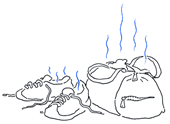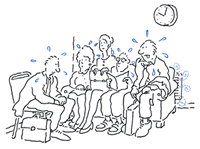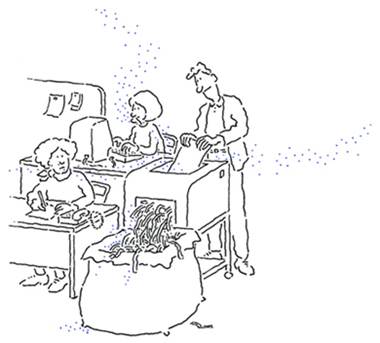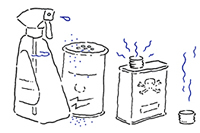Indoor Air Quality (IAQ) - Tips for Improving the Air Quality in Your Office

November 2000, revised April 2005
At Public Works and Government Services Canada (PWGSC), we care about the quality of the indoor air you breathe. When we investigate indoor air problems reported by our property managers, we often find air quality is affected by minor problems - problems that can be easily avoided if we work together.
We've produced this booklet to help you recognize the factors that affect indoor air quality at work. Inside, you'll find useful tips on how to improve air quality in your workplace.
Our goal is to provide you with accommodation that is safe, healthy and comfortable.
So read on, and breathe easier!
What is Indoor Air Quality?
In the great outdoors, there's plenty of fresh air. But we spend most of our time indoors, surrounded by walls, furniture, paper, plastics, chemicals, food, dust and, of course, other people. All of these can affect the quality of our indoor air.
At Public Works and Government Services Canada, our job is to make sure that you have the best-quality indoor air possible. To do this, we focus on providing clean and conditioned air, and on eliminating or reducing pollutants from your work environment.
Source control is the best way to achieve good indoor air quality. Ventilation, or bringing in outside air, simply dilutes indoor pollutant levels.
Communication is the Key
It's very important that you let us know when you have a problem with the air in your workplace. This is easy to do: simply contact your facilities or property manager. (That person's title may vary, depending on the department or even the building in which you work.) Usually, the person you contact to get a new light bulb or to have the heat turned up or down is your facilities manager. In some cases, you may have a centralized "help desk" number that you can call to report problems.
What Am I Breathing?
Today, engineers design buildings to provide 10 litres of outdoor air to every person, every second. That's a lot of air! Sometimes during the winter and summer season we recirculate up to 85 percent of the indoor air, as building systems cannot heat or cool more outside air. The recirculated air is mixed with outdoor air, filtered and conditioned several times each hour to provide thermal comfort and ventilation.

 But Why Can't We Open The Windows?
But Why Can't We Open The Windows?
Tall buildings work like giant chimney stacks, especially during the winter when we have to heat indoor air. If people leave the windows open on every floor, the building draws in cold air at the bottom and pushes warm air up. This is called the "stack effect". As a result, people on lower floors freeze, and those on upper floors swelter. Because of the stack effect, it is better to have a mechanically controlled environment, providing thermal comfort and clean filtered air for everyone.
Help Us Help You
Here's a list of some of the most common, easy-to-avoid situations that affect indoor air quality. Don't block your vents with furniture or other objects. You'll cut off the air flow and prevent proper heating and cooling.

Don't block horizontal vents in window bays with things like books and files. When this happens, air can't flow normally over the window. This reduces the supply of fresh air and promotes condensation on the glass. Condensation eventually causes water damage and even mould growth, which may pose health problems for people with allergies or environmental sensitivities.

Engineers design buildings to distribute air throughout workspaces according to specific requirements. Not all air-supply openings provide the same amount of air, so if yours is giving out more or less, it doesn't automatically mean there's anything wrong.

Call your facilities manager if you need help. Trying to prevent problems yourself can lead to even more trouble. So: Never tape up air-supply openings to stop drafts. You may affect the air circulation in more than just your workspace. Let your facilities manager know if there's a draft so the proper adjustments can be made.

Never adjust or redirect the ventilation system yourself, and don't move ceiling tiles. These changes can affect the air circulation throughout an entire office area.

If your work area is equipped with an adjustable thermostat, take a few moments to understand how it works before changing the setting. It may control the heat in workspaces other than yours, and adjusting it may affect the comfort of your colleagues.
Remember Your Colleagues

Personal habits often affect the quality of air in the workplace. While many minor problems are insignificant by themselves, every bit of pollution adds up. By remembering the simple tips below, you'll be doing your part to promote a clean, odour-free, pleasant place to work. Keep your lunch room or break area clean so odours don't develop.

Clean up water and coffee spills. Mould can grow in damp or wet areas. Remember that few people appreciate the smell of gym clothes, damp boots, or other odours. Avoid wearing strong perfumes and aftershave lotions. Many people are sensitive, or even allergic to them.

Use whiteout and magic markers as seldom as possible. When they're not in use, put the lid on them. Avoid using air fresheners. They only mask odours. Using one odour to mask another simply adds pollutants to the air.

Take care of your plants, and make sure there's a tray under them to catch any leaks from over watering. If your plant is sick, get professional advice. Do not treat it with chemicals.
On A Personal Level

We all react differently to factors we encounter in the workplace. You should take all problems seriously, and talk to your facilities manager about them. Remember that putting up with stress or discomfort caused by the workplace does no one any good. Keep in mind that environmental and work-related factors other than indoor air quality can cause stress and headaches. Examples include glare from computer screens, flickering fluorescent lights, inadequate lighting and noise. If you're having problems in your workspace and your colleagues aren't, you may be more environmentally sensitive than others. If you think this might be the case, let your supervisor know and perhaps see your doctor. If you are aware of what causes adverse reactions, perhaps your supervisor and facilities manager can modify your workplace.
Converting Office Space
When converting office space, chances are you'll need advice on indoor air quality, which you can easily get by contacting Public Works and Government Services Canada through your facilities manager.

Modern ventilation systems are custom-designed to match the space layout and activities of your organization. Ducts and vents are part of that design. When space layouts change, you may also need to have your air distribution system modified. Make sure your facilities manager knows about any layout changes, so he/she can properly assess your ventilation needs.

If you convert office space into a boardroom or waiting room, you'll need more air and cooling for extra people. We can advise you about an appropriate control system.

If you convert open office space into individual, closed offices, you may create a need for extra air distribution units and thermostats to make sure you're getting the proper amount of air, and the right temperature. Again, contact your facilities manager. All this is called "commissioning" and space that is refitted should be recommissioned.
The Effects of Office Machines

Even office machines affect the work environment. Some give off heat, and some emit chemicals. You may have poor indoor air quality if they're not properly installed and used. If you suspect your office machines are polluting your work environment, call your facilities manager. We'll let you know if your existing ventilation system can handle it, or if we'll have to adjust it.
In the meantime, you should be aware of the following: Before installing machines such as photocopiers or printers, have your facilities manager assess the best location for each machine, and whether you'll need special ventilation. In some cases, equipment may need to be placed in a separate room with exhaust hoods that vent directly to the outside. If office machines are making your work area dirty, hot or smelly, it's time to have the situation assessed. If a paper shredder is creating a lot of dust, it might have to be moved to a specially ventilated room. All equipment should have scheduled maintenance and this is usually contracted.
Humidity and Your Comfort
Humidity is important in making the workplace comfortable. However, in many older buildings or when it's cold outside, it's hard to attain comfortable humidity levels. In trying, we often end up with humidity levels which cause condensation on windows, mould and mildew growth, and damp walls. This can be both unhealthy for people and damaging to buildings.
You'll be playing your part if you do the following: Report excessive condensation on windows. Report all water leaks. Check water coolers for slime or mould growth. These require regular cleaning.

Water plants carefully to avoid spilling water on carpets where mould can grow. Avoid using personal humidifiers. The water in these can become contaminated and pollute the surrounding air. If you think the air is too dry, get the humidity level checked.
Chemical Pollutants

Workplaces always contain materials that release small amounts of chemicals, so you should be careful to do the following:
Tightly seal and safely store all office chemicals, like solvents and cleaning compounds. Choose low-odour products, or products that emit fewer chemicals. Do not use an ozone generator at work (or at home, for that matter). Ozone is a toxic gas.
To Conclude
Whether Public Works and Government Services Canada is constructing, leasing, renovating or refitting buildings, we're committed to making your workplace a more comfortable place. By using the tips in this booklet, you'll be doing your part to make indoor air quality your priority -- it's a team effort.
And remember... if you have a problem with indoor air quality, we have test equipment, prevention checklists, and specialists who can help you improve the situation. Together, we can help.

Resources

Links to sites external to PWGSC are provided as a convenience to users. PWGSC is not responsible for the information found at these sites. Please note that only Web sites originating from Canadian federal institutions are subject to the Official Languages Act. Other links, which may originate from various sites throughout the world, might only be present in their original language, English or French.
Canadian Mortgage and Housing Corporation (CMHC)
Health Canada
- Health Canada
- Indoor Air Quality in Office Buildings: A Technical Guide
- Exposure Guidelines for Residential Indoor Air Quality
- Indoor Air Quality
- Fungal contamination in public buildings: A guide to recognition and management
- Questions and Answers on Bottled Water
U.S. Environmental Protection Agency
- U.S. Environmental Protection Agency

- IAQ in Large Buildings

- Indoor Air Quality (IAQ) in Homes/Residences

- Should you have the Air Ducts in Your Home Cleaned?

- An Office Building Occupant's Guide to Indoor Air Quality

- Fact Sheet Ventilation and Air Quality in Offices

- Indoor Air Facts No. 4 - Sick Building Syndrome

- Indoor Air Facts No. 8 Use and Care of Home Humidifiers

- Fact Sheet Flood Cleanup

- The Inside Story: Guide to Indoor Air Quality

- Indoor Air Pollution: An Introduction to Health Professionals

- Biological Pollutants in Your Home

- Indoor Air Quality Basics for Schools

